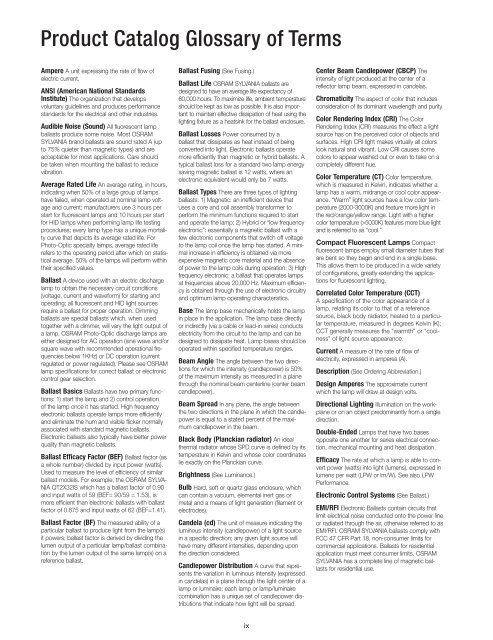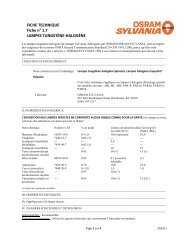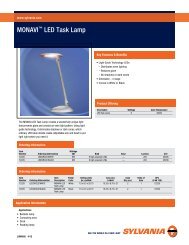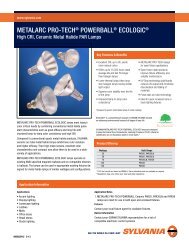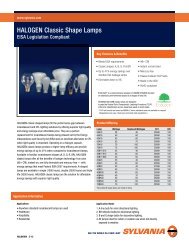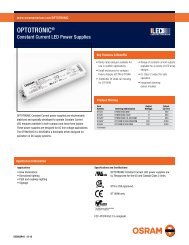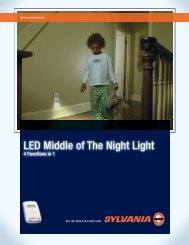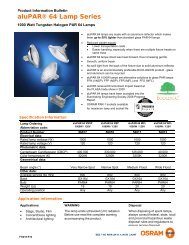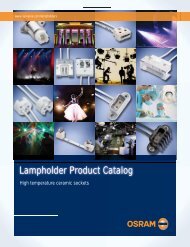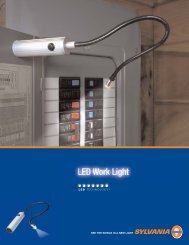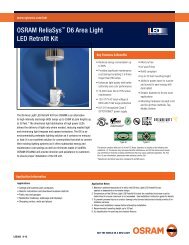Lamp and Ballast Catalog - Osram Sylvania
Lamp and Ballast Catalog - Osram Sylvania
Lamp and Ballast Catalog - Osram Sylvania
You also want an ePaper? Increase the reach of your titles
YUMPU automatically turns print PDFs into web optimized ePapers that Google loves.
Product <strong>Catalog</strong> Glossary of Terms<br />
Ampere A unit expressing the rate of flow of<br />
electric current.<br />
ANSI (American National St<strong>and</strong>ards<br />
Institute) The organization that develops<br />
voluntary guidelines <strong>and</strong> produces performance<br />
st<strong>and</strong>ards for the electrical <strong>and</strong> other industries.<br />
Audible Noise (Sound) All fluorescent lamp<br />
ballasts produce some noise. Most OSRAM<br />
SYLVANIA br<strong>and</strong> ballasts are sound rated A (up<br />
to 75% quieter than magnetic types) <strong>and</strong> are<br />
acceptable for most applications. Care should<br />
be taken when mounting the ballast to reduce<br />
vibration.<br />
Average Rated Life An average rating, in hours,<br />
indicating when 50% of a large group of lamps<br />
have failed, when operated at nominal lamp voltage<br />
<strong>and</strong> current; manufacturers use 3 hours per<br />
start for fluorescent lamps <strong>and</strong> 10 hours per start<br />
for HID lamps when performing lamp life testing<br />
procedures; every lamp type has a unique mortality<br />
curve that depicts its average rated life. For<br />
Photo-Optic specialty lamps, average rated life<br />
refers to the operating period after which on statistical<br />
average, 50% of the lamps will perform within<br />
their specified values.<br />
<strong>Ballast</strong> A device used with an electric discharge<br />
lamp to obtain the necessary circuit conditions<br />
(voltage, current <strong>and</strong> waveform) for starting <strong>and</strong><br />
operating; all fluorescent <strong>and</strong> HID light sources<br />
require a ballast for proper operation. Dimming<br />
ballasts are special ballasts which, when used<br />
together with a dimmer, will vary the light output of<br />
a lamp. OSRAM Photo-Optic discharge lamps are<br />
either designed for AC operation (sine wave <strong>and</strong>/or<br />
square wave with recommended operational frequencies<br />
below 1KHz) or DC operation (current<br />
regulated or power regulated). Please see OSRAM<br />
lamp specifications for correct ballast or electronic<br />
control gear selection.<br />
<strong>Ballast</strong> Basics <strong>Ballast</strong>s have two primary functions:<br />
1) start the lamp <strong>and</strong> 2) control operation<br />
of the lamp once it has started. High frequency<br />
electronic ballasts operate lamps more efficiently<br />
<strong>and</strong> eliminate the hum <strong>and</strong> visible flicker normally<br />
associated with st<strong>and</strong>ard magnetic ballasts.<br />
Electronic ballasts also typically have better power<br />
quality than magnetic ballasts.<br />
<strong>Ballast</strong> Efficacy Factor (BEF) <strong>Ballast</strong> factor (as<br />
a whole number) divided by input power (watts).<br />
Used to measure the level of efficiency of similar<br />
ballast models. For example, the OSRAM SYLVA-<br />
NIA QT2X32IS which has a ballast factor of 0.90<br />
<strong>and</strong> input watts of 59 (BEF= 90/59 = 1.53), is<br />
more efficient than electronic ballasts with ballast<br />
factor of 0.875 <strong>and</strong> input watts of 62 (BEF=1.41).<br />
<strong>Ballast</strong> Factor (BF) The measured ability of a<br />
particular ballast to produce light from the lamp(s)<br />
it powers; ballast factor is derived by dividing the<br />
lumen output of a particular lamp/ballast combination<br />
by the lumen output of the same lamp(s) on a<br />
reference ballast.<br />
<strong>Ballast</strong> Fusing (See Fusing.)<br />
<strong>Ballast</strong> Life OSRAM SYLVANIA ballasts are<br />
designed to have an average life expectancy of<br />
60,000 hours. To maximize life, ambient temperature<br />
should be kept as low as possible. It is also important<br />
to maintain effective dissipation of heat using the<br />
lighting fixture as a heatsink for the ballast enclosure.<br />
<strong>Ballast</strong> Losses Power consumed by a<br />
ballast that dissipates as heat instead of being<br />
converted into light. Electronic ballasts operate<br />
more efficiently than magnetic or hybrid ballasts. A<br />
typical ballast loss for a st<strong>and</strong>ard two lamp energy<br />
saving magnetic ballast is 12 watts, where an<br />
electronic equivalent would only be 7 watts.<br />
<strong>Ballast</strong> Types There are three types of lighting<br />
ballasts: 1) Magnetic: an inefficient device that<br />
uses a core <strong>and</strong> coil assembly transformer to<br />
perform the minimum functions required to start<br />
<strong>and</strong> operate the lamp; 2) Hybrid or “low frequency<br />
electronic”: essentially a magnetic ballast with a<br />
few electronic components that switch off voltage<br />
to the lamp coil once the lamp has started. A minimal<br />
increase in efficiency is obtained via more<br />
expensive magnetic core material <strong>and</strong> the absence<br />
of power to the lamp coils during operation; 3) High<br />
frequency electronic: a ballast that operates lamps<br />
at frequencies above 20,000 Hz. Maximum efficiency<br />
is obtained through the use of electronic circuitry<br />
<strong>and</strong> optimum lamp operating characteristics.<br />
Base The lamp base mechanically holds the lamp<br />
in place in the application. The lamp base directly<br />
or indirectly (via a cable or lead-in wires) conducts<br />
electricity from the circuit to the lamp <strong>and</strong> can be<br />
designed to dissipate heat. <strong>Lamp</strong> bases should be<br />
operated within specified temperature ranges.<br />
Beam Angle The angle between the two directions<br />
for which the intensity (c<strong>and</strong>lepower) is 50%<br />
of the maximum intensity as measured in a plane<br />
through the nominal beam centerline (center beam<br />
c<strong>and</strong>lepower).<br />
Beam Spread In any plane, the angle between<br />
the two directions in the plane in which the c<strong>and</strong>lepower<br />
is equal to a stated percent of the maximum<br />
c<strong>and</strong>lepower in the beam.<br />
Black Body (Planckian radiator) An ideal<br />
thermal radiator whose SPD curve is defined by its<br />
temperature in Kelvin <strong>and</strong> whose color coordinates<br />
lie exactly on the Planckian curve.<br />
Brightness (See Luminance.)<br />
Bulb Hard, soft or quartz glass enclosure, which<br />
can contain a vacuum, elemental inert gas or<br />
metal <strong>and</strong> a means of light generation (filament or<br />
electrodes).<br />
C<strong>and</strong>ela (cd) The unit of measure indicating the<br />
luminous intensity (c<strong>and</strong>lepower) of a light source<br />
in a specific direction; any given light source will<br />
have many different intensities, depending upon<br />
the direction considered.<br />
C<strong>and</strong>lepower Distribution A curve that represents<br />
the variation in luminous intensity (expressed<br />
in c<strong>and</strong>elas) in a plane through the light center of a<br />
lamp or luminaire; each lamp or lamp/luminaire<br />
combination has a unique set of c<strong>and</strong>lepower distributions<br />
that indicate how light will be spread.<br />
ix<br />
Center Beam C<strong>and</strong>lepower (CBCP) The<br />
intensity of light produced at the center of a<br />
reflector lamp beam, expressed in c<strong>and</strong>elas.<br />
Chromaticity The aspect of color that includes<br />
consideration of its dominant wavelength <strong>and</strong> purity.<br />
Color Rendering Index (CRI) The Color<br />
Rendering Index (CRI) measures the effect a light<br />
source has on the perceived color of objects <strong>and</strong><br />
surfaces. High CRI light makes virtually all colors<br />
look natural <strong>and</strong> vibrant. Low CRI causes some<br />
colors to appear washed out or even to take on a<br />
completely different hue.<br />
Color Temperature (CT) Color temperature,<br />
which is measured in Kelvin, indicates whether a<br />
lamp has a warm, midrange or cool color appearance.<br />
“Warm” light sources have a low color temperature<br />
(2000-3000K) <strong>and</strong> feature more light in<br />
the red/orange/yellow range. Light with a higher<br />
color temperature (>5000K) features more blue light<br />
<strong>and</strong> is referred to as “cool.”<br />
Compact Fluorescent <strong>Lamp</strong>s Compact<br />
fluorescent lamps employ small diameter tubes that<br />
are bent so they begin <strong>and</strong> end in a single base.<br />
This allows them to be produced in a wide variety<br />
of configurations, greatly extending the applications<br />
for fluorescent lighting.<br />
Correlated Color Temperature (CCT)<br />
A specification of the color appearance of a<br />
lamp, relating its color to that of a reference<br />
source, black body radiator, heated to a particular<br />
temperature, measured in degrees Kelvin (K);<br />
CCT generally measures the “warmth” or “coolness”<br />
of light source appearance.<br />
Current A measure of the rate of flow of<br />
electricity, expressed in amperes (A).<br />
Description (See Ordering Abbreviation.)<br />
Design Amperes The approximate current<br />
which the lamp will draw at design volts.<br />
Directional Lighting Illumination on the workplane<br />
or on an object predominantly from a single<br />
direction.<br />
Double-Ended <strong>Lamp</strong>s that have two bases<br />
opposite one another for series electrical connection,<br />
mechanical mounting <strong>and</strong> heat dissipation.<br />
Efficacy The rate at which a lamp is able to convert<br />
power (watts) into light (lumens), expressed in<br />
lumens per watt (LPW or lm/W). See also LPW<br />
Performance.<br />
Electronic Control Systems (See <strong>Ballast</strong>.)<br />
EMI/RFI Electronic <strong>Ballast</strong>s contain circuits that<br />
limit electrical noise conducted onto the power line<br />
or radiated through the air, otherwise referred to as<br />
EMI/RFI. OSRAM SYLVANIA ballasts comply with<br />
FCC 47 CFR Part 18, non-consumer limits for<br />
commercial applications. <strong>Ballast</strong>s for residential<br />
application must meet consumer limits. OSRAM<br />
SYLVANIA has a complete line of magnetic ballasts<br />
for residential use.


